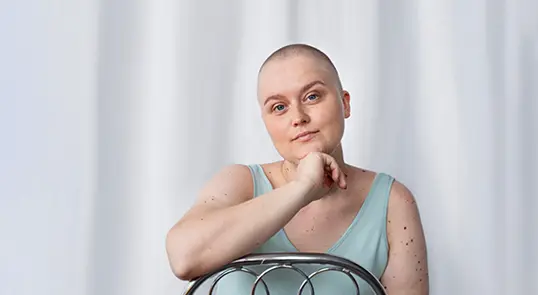AYAs With Acute Lymphoblastic Leukemia (ALL):

ALL in adolescents and young adults (AYAs) and adults1
ALL is not just a childhood cancer; 46% of new ALL cases occur in adults.

17 years
: Median age at diagnosis
of new ALL cases occur in people aged ≥20 years
of patients in this age group lose their fight against ALL
Challenges unique to AYA patients
ALL affects the AYA population, defined as those aged between 15 and 39 years, differently and with different outcomes than in children.2-4
A prognosis that varies by age and genetics
Pediatric
High hyperdiploidy and ETV6-RUNX1 are more prevalent in the pediatric population and are associated with favorable outcomes5,6
91%
5-year relative survival for children7
AYA
Aged 15 to 39 years
Ph+ ALL is more prevalent in the AYA population and is associated with poor prognosis5,6
60%
5-year relative survival for AYAs7
Abbreviation: Ph, Philadelphia chromosome.
Considerations in AYA patients
When it comes to treatment, AYA patients present with a range of age-related and age-specific issues that include8
- Long-term side effects
- Logistical issues such as transportation to clinic appointments, maintaining school and work obligations, and childcare
Of significant importance for this age group is the preservation of fertility.9,10
The impact of cancer treatment on fertility is related to the age of the patient at the time of diagnosis and treatment, and is dependent on the type, duration, and dose intensity of treatment.11,12
All NCCN Clinical Practice Guidelines in Oncology (NCCN Guidelines®) preferred regimens for frontline therapy for AYA patients with Ph-negative ALL contain pegaspargase (ONCASPAR).2

ONCASPAR-containing regimens are the first line of defense for AYA patients with ALL13
NCCN Guidelines® Recommend Regimens That Include Pegaspargase (ONCASPAR®) for the Treatment of Ph-Negative B-Cell and T-Cell ALL in AYA and Adult Patients2,a
Preferred Regimens
- CALGB 10403 regimen: daunorubicin, vincristine, prednisone, and pegaspargaseb,c
- COG AALL0232 regimen: daunorubicin, vincristine, prednisone, and pegaspargaseb (patients aged ≤21 years)c
- COG AALL0434 regimen with nelarabine (for T-cell ALL): daunorubicin, vincristine, prednisone, pegaspargaseb; and nelarabinec
- DFCI ALL regimen based on DFCI Protocol 00-01: doxorubicin, vincristine, prednisone, high-dose methotrexate, and pegaspargaseb,c
Other Recommended Regimens
- GRAALL-2005 regimen: daunorubicin, vincristine, prednisone, pegaspargase,b and cyclophosphamide (patients aged <60 years), with rituximab for CD20-positive diseasec
- PETHEMA ALL-96 regimen: daunorubicin, vincristine, prednisone, pegaspargase,b and cyclophosphamide (patients aged <30 years)c
- Hyper-CVAD: hyperfractionated cyclophosphamide, vincristine, doxorubicin, and dexamethasone, alternating with high-dose methotrexate and cytarabine; with rituximab for CD20-positive disease
- USC/MSKCC ALL regimen based on CCG-1882 regimen: daunorubicin, vincristine, prednisone, and methotrexate with augmented pegaspargaseb (patients aged 18-60 years)c
- Linker 4-drug regimen: daunorubicin, vincristine, pegaspargase,b and prednisone; with rituximab for CD20-positive disease
- Blinatumomabd
Recommended Regimens
- CALGB 8811 Larson regimen: daunorubicin, vincristine, prednisone, pegaspargaseb, and cyclophosphamide; for patients aged ≥60 years, reduced doses for cyclophosphamide, daunorubicin, and prednisone
- GRAALL-2005 regimen: daunorubicin, vincristine, prednisone, pegaspargaseb, and cyclophosphamide (patients aged <60 years) with rituximab for CD20-positive disease
- Hyper-CVAD: hyperfractionated cyclophosphamide, vincristine, doxorubicin, and dexamethasone, alternating with high-dose methotrexate and cytarabine; with rituximab for CD20-positive disease
- USC/MSKCC ALL regimen based on CCG-1882 regimen: daunorubicin, vincristine, prednisone, and methotrexate with augmented pegaspargaseb (patients aged <60 years)c
- Linker 4-drug regimen: daunorubicin, vincristine, prednisone, and pegaspargaseb; with rituximab for CD20-positive disease (patients aged <60 years)
- MRC UKALLXII/ECOG2993 regimen: daunorubicin, vincristine, prednisone, and pegaspargaseb (induction phase I); and cyclophosphamide, cytarabine, and 6-MPe,f (induction phase II)
- Blinatumomabd
a The ALL Panel considers AYAs to be between the ages of 15 and 39 years. However, this age range is not a firm reference point because some of the recommended regimens have not been comprehensively tested across all ages.
bPegaspargase may be substituted with calaspargase pegol-mknl, an asparagine-specific enzyme, in patients aged ≤21 years for more sustained asparaginase activity.
cPediatric-inspired regimen.
dBlinatumomab can be considered for consolidation in MRD negative/unavailable if induced with inotuzumab ozogamicin + mini-hyperCVD, or in patients for whom multi-agent chemotherapy is contraindicated, and for consolidation in persistent/rising MRD.
eFor patients receiving 6-MP, consider testing for TPMT gene polymorphisms, particularly in patients who develop severe neutropenia after starting 6-MP. Testing for both TPMT and NUDT15 variant status should be considered, especially for patients of East Asian origin.
eDose modifications for antimetabolites in maintenance should be consistent with the chosen treatment regimen. It may be necessary to reduce dose/eliminate antimetabolite in the setting of myelosuppression and/or hepatotoxicity.
Abbreviations: 6-MP, mercaptopurine; CALGB, Cancer and Leukemia Group B; CCG, Children’s Cancer Group; COG, Children’s Oncology Group; CVAD, cyclophosphamide, vincristine, doxorubicin, and dexamethasone; DFCI, Dana-Farber Cancer Insitute; ECOG, Eastern Cooperative Oncology Group; GRAALL, Group for Research on Adult Acute Lymphoblastic Leukemia; MRC, Medical Research Council; MRD, minimal residual disease; NCCN, National Comprehensive Cancer Network®; PETHEMA, Programa de Estudio y Tratamiento de las Hemopatías Malignas; USC/MSKCC, University of Southern California/Memorial Sloan Kettering Cancer Center.
ONCASPAR FAQs
Get answers to frequently asked questions about ONCASPAR.
